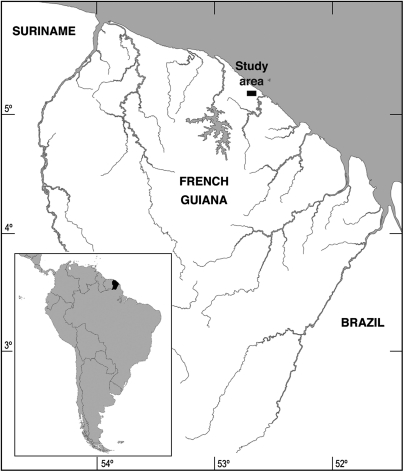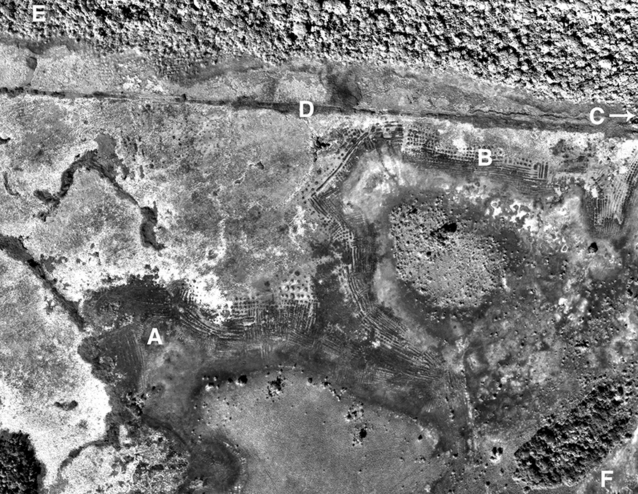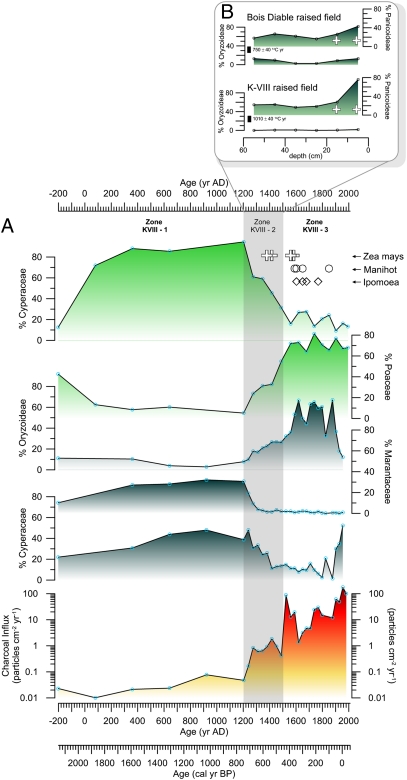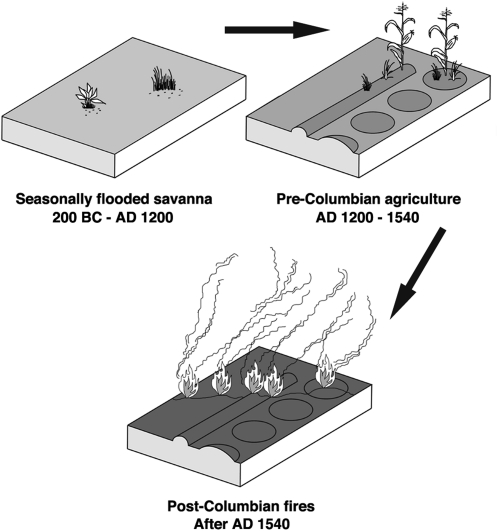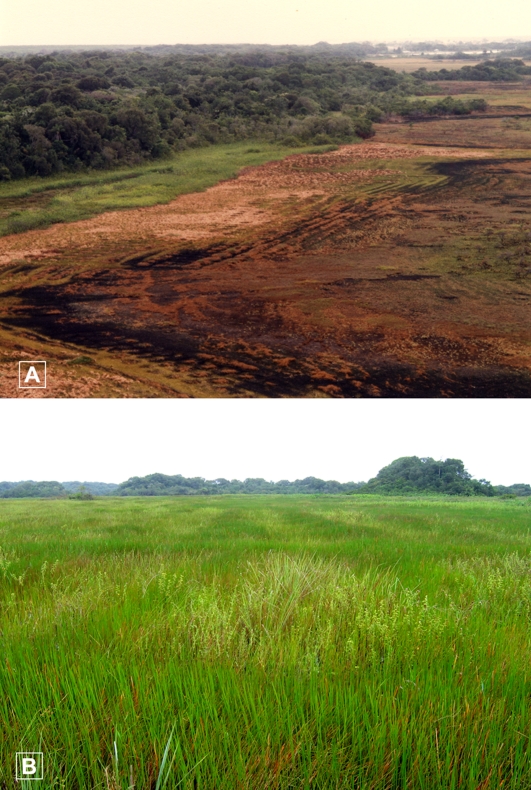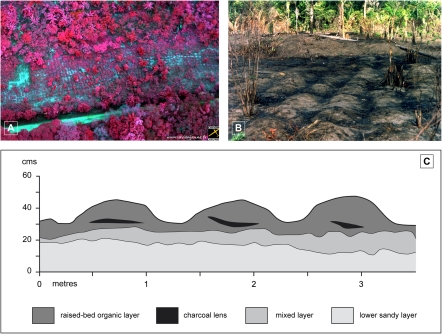Abstract
The nature and scale of pre-Columbian land use and the consequences of the 1492 “Columbian Encounter” (CE) on Amazonia are among the more debated topics in New World archaeology and paleoecology. However, pre-Columbian human impact in Amazonian savannas remains poorly understood. Most paleoecological studies have been conducted in neotropical forest contexts. Of studies done in Amazonian savannas, none has the temporal resolution needed to detect changes induced by either climate or humans before and after A.D. 1492, and only a few closely integrate paleoecological and archaeological data. We report a high-resolution 2,150-y paleoecological record from a French Guianan coastal savanna that forces reconsideration of how pre-Columbian savanna peoples practiced raised-field agriculture and how the CE impacted these societies and environments. Our combined pollen, phytolith, and charcoal analyses reveal unexpectedly low levels of biomass burning associated with pre-A.D. 1492 savanna raised-field agriculture and a sharp increase in fires following the arrival of Europeans. We show that pre-Columbian raised-field farmers limited burning to improve agricultural production, contrasting with extensive use of fire in pre-Columbian tropical forest and Central American savanna environments, as well as in present-day savannas. The charcoal record indicates that extensive fires in the seasonally flooded savannas of French Guiana are a post-Columbian phenomenon, postdating the collapse of indigenous populations. The discovery that pre-Columbian farmers practiced fire-free savanna management calls into question the widely held assumption that pre-Columbian Amazonian farmers pervasively used fire to manage and alter ecosystems and offers fresh perspectives on an emerging alternative approach to savanna land use and conservation that can help reduce carbon emissions.
Keywords: pre-Columbian agriculture, anthropogenic fire, indigenous fire practices, savanna ecology, tropical seasonal wetlands
Mounting archaeological and paleoecological evidence indicates that societies of considerable size and complexity emerged in some regions of Amazonia and began to transform landscapes at an unprecedented scale during the late Holocene (1–4). Anthropogenic dark-earth soils associated with intensive agriculture developed along the bluffs of major rivers in forested areas of Amazonia and its periphery, and large expanses of previously uncultivated seasonally flooded savannas were reclaimed for intensive raised-field agricultural systems (5, 6).
Many seasonally flooded tropical savannas of South and Central America, such as the coastal belt of the Guianas (7), the Mompos depression in Colombia (8), and the Beni in the Bolivian Amazon (9), were reclaimed into vast agricultural landscapes through the construction of raised fields by pre-Columbian farmers during the Late Holocene. Early European chronicles illustrate the practice of raised-field agriculture by the Otomac in Venezuela (10) and by the Tainos in Hispaniola (11), who constructed small mounds using wooden tools similar to the Arauquinoid shovel found in Suriname and dating to around A.D. 1240 (12). Raised-field agriculture provided pre-Columbian farmers with better drainage, soil aeration, and moisture retention (important for these environments subjected to a long rainy season and a severe dry season), increased fertility, and possibly easier weeding and harvesting. In addition, channels between raised fields can be used for fish and turtle farming, and their muck and aquatic vegetation can provide a renewable source of nutrients for the soil. Modern raised-field experiments show that raised fields can be very productive, yielding between 2 and 5.8 t ha−1 of maize (Zea mays L.) and up to 21 t ha−1 of manioc (Manihot esculenta Crantz), and could thus have supported large and concentrated populations (13).
The A.D. 1492 “Columbian Encounter” (CE) (14, 15) set in motion dramatic changes in land use that significantly affected these landscapes shaped by pre-Columbian intensive agriculture. Previous studies show a late-Holocene surge in anthropogenic burning attributed to pre-Columbian agricultural intensification, both through a more intensive practice of slash-and-burn agriculture and through a more sedentary type of agriculture that led to the formation of charcoal-rich, dark-earth soils (16–22). This surge was followed by a sharp post-Columbian (post-A.D. 1492) decline in anthropogenic burning, and subsequent reforestation, attributed to indigenous population collapse resulting from the arrival of European diseases (16–19, 21, 22). However, these studies are from tropical forest contexts. Both fire history in neotropical savannas and the impact of the CE on these ecosystems remain poorly understood. Furthermore, lake-sediment records located in Amazonian savanna contexts lack the temporal resolution necessary to detect changes induced by either climate or humans before and after A.D. 1492.
Here, we provide a unique perspective on pre- versus post-Columbian savanna land use through analysis of a high-resolution, 2,150-y record of pollen, phytolith, and charcoal in a sediment core taken in a French Guianan coastal savanna. Contrary to fire reconstructions from neotropical forests (18, 19, 21–23) and lake records from Central American savannas (24, 25), our data show unexpectedly low levels of late-Holocene biomass burning, which we attribute to fire limitation by pre-Columbian raised-field farmers, and a dramatic increase in fires associated with the post-Columbian demise of labor-intensive raised-field systems. A better understanding of how pre-Columbian inhabitants managed savanna environments—in the case studied here, over the course of two or more centuries of raised-field agriculture—may provide insights into the sustainable use and conservation of these globally important ecosystems, which currently occupy 20% of the lowland neotropics and are being destroyed at an alarmingly high rate (26, 27).
Results and Discussion
Coastal landscapes of French Guiana are characterized by waterfront mangrove vegetation along the Atlantic seashore mud flats. Progressively further inland are found, in turn, freshwater marshes, seasonally flooded savannas with scattered forest patches, and terra firme tropical forest. The coastal savannas are bounded by Late Quaternary marine terraces that run parallel to the seashore (4). Current climate is marked by highly seasonal annual rainfall, between 2,500 and 4,000 mm, most of it during the December to July rainy season (4). Remnants of pre-Columbian agricultural landscapes along the Guianan coast are characterized by raised fields, canals, and ponds, which extend over ∼600 km, from the Berbice River in Guyana to near Cayenne (Fig. 1) (7).
Fig. 1.
Location of the study area.
The K-VIII peat core (5° 11′ 54.72′′ N, 52° 41′ 39.92′′ W; 5 m above sea level) (Figs. 1 and 2) was extracted in 2007 with a Russian corer from a ∼8-ha wetland in the seasonally flooded savannas of French Guiana. The 31.5-cm deep K-VIII core represents the past 2,150 calendar years (Fig. S1). The K-VIII complex of pre-Columbian agricultural raised fields is located nearby (Fig. 2).
Fig. 2.
Aerial photo (1987; 1:8,000) of the study area showing: (A) K-VIII core site; (B) K-VIII pre-Columbian agricultural raised fields; (C) Bois Diable pre-Columbian agricultural raised fields (located 3.5 km east of the K-VIII core); (D) colonial drainage canal (canal Leroy, 18th Century); (E and F), colonial agricultural raised beds under forest and in open areas, respectively (source: Institut National de l'Information Géographique et Forestière, Paris, France).
Vegetation History.
Between ∼200 B.C. and A.D. 1200 (zone K-VIII-1), the landscape was a seasonally flooded savanna, dominated by Cyperaceae and Marantaceae, with negligible charcoal abundance and low percentages of grass (Poaceae) pollen (Fig. 3A, and Figs. S1–S3). At approximately A.D. 1200, marked decreases in Cyperaceae and Marantaceae, paralleled by a sharp increase in Poaceae pollen and the first appearance of maize (Zea mays) pollen (Fig. S4), signify the initial construction and use of agricultural raised fields (Figs. 3A and 4). Maize phytoliths are also found at this time in the K-VIII and Bois Diable raised fields (Fig. 3B). Today, sedges are more abundant in intermound areas, and panicoid grasses dominate atop well-drained mounds (4) (Fig. 5B). We therefore interpret the declines in Cyperaceae and Marantaceae pollen and phytoliths as signifying a reduction in extent of seasonally flooded savanna, but the concomitant expansion of Poaceae pollen reflects increased terra firme (nonflooded) habitat provided by the raised fields (Figs. 3A and 4).
Fig. 3.
(A) Percentage pollen (light green) and phytolith (dark green) diagram of selected plant taxa and macroscopic charcoal influx (red) from the K-VIII peat swamp core. Symbols represent presence of cultigens: maize ( ), manioc (○), sweet potato (◇). (B) Percentage phytolith diagram of selected plant taxa from soil profiles from the K-VIII and Bois Diable pre-Columbian agricultural raised fields. The dates show the age of the uppermost levels of the buried A horizon (peat) immediately below the overlying raised-field soils.
), manioc (○), sweet potato (◇). (B) Percentage phytolith diagram of selected plant taxa from soil profiles from the K-VIII and Bois Diable pre-Columbian agricultural raised fields. The dates show the age of the uppermost levels of the buried A horizon (peat) immediately below the overlying raised-field soils.
Fig. 4.
Schematic drawing of changing vegetation and disturbance regimes as inferred from analysis of pollen, phytoliths, and charcoal from the K-VIII core.
Fig. 5.
(A) Aerial view of the K-VIII pre-Columbian raised-field complex after burning (photo: S. Rostain, 1989). (B) Field view of the K-VIII site during the rainy season, showing grasses (Poaceae; light green) growing on top of pre-Columbian raised fields and sedges (Cyperaceae; dark green) growing in the intervening canals.
Our inference that greater abundance of Poaceae pollen in zone K-VIII-2 relative to zone K-VIII-1 reflects grasses growing upon raised fields is strengthened by the dominance of panicoid grass phytoliths throughout the soil profiles of raised fields of comparable age (between approximately A.D. 1040 and 1250) located about 700 m and 4 km away from the core site (Figs. 2 and 3B) (4, 13). Further support comes from other raised-field sites in the region, where panicoid phytoliths dominate in mound soil profiles and Cyperaceae phytoliths are more abundant in intermound profiles (4, 13). Another major change in the K-VIII core during the “raised-field farmer” period is the increase in wild rice (Poaceae: Oryzoideae) phytoliths (Fig. S3). Wild rices thrive in wetland margins; we interpret their increase as having resulted from the multiplication of wetland border habitats that took place with the establishment of raised fields in these previously seasonally inundated savannas. The drainage that took place in the colonial period, through the construction of canals, further lowered water levels and promoted the growth of wild rice. Our dates for initial construction of raised fields are broadly contemporaneous with the presence of Arauquinoid raised-field farmer groups, which originated in the Middle Orinoco around A.D. 450, reached western coastal Suriname around A.D. 650, and spread eastward to the vicinity of Cayenne (28). In our study area the Arauquinoid tradition is represented by the Barbakoeba and Thémire cultures, which began approximately A.D. 950 and 1150, respectively (4, 28).
Fire History.
The low abundance of charcoal through the raised-field zone K-VIII-2 is unexpected, given the large increase in this zone (relative to the previous zone) of fire-prone grasses. Our findings are at odds with neotropical fire-history reconstructions from lowland forests and from Central American savanna environments that show maximum fire activity during this period (18, 19, 21, 22, 24, 25). For example, documented high pre-Columbian fire activity in rainforest of neighboring central Guyana (29) is not reflected in the K-VIII core. The low charcoal abundance in zone K-VIII-2 is most parsimoniously explained by the implementation of fire limitation practices by pre-Columbian raised-field farmers, especially because our study area is characterized by a long dry season and commensurate high fire probability (30).
Fire limitation would have presented advantages for raised-field agriculture. Fires result in the loss of nutrients, such as nitrogen and phosphorus, through formation of gases and aerosols (31, 32). Fallows would probably have been most effective at restoring plant biomass, soil organic matter, and soil structure for the next cycle of raised-field agriculture in the absence of fire (33–35). Furthermore, tight control of burning would have also avoided the labor cost of weeding fire-adapted plants (33).
The record shows a clear correlation between the dramatic increase in charcoal abundance beginning approximately A.D. 1540 and the arrival of Europeans in this coastal region. In A.D. 1500, the Spanish explorer Vincente Yánez Pinzón, after discovering the mouth of the Amazon River, sailed northwest and entered the Oyapock River, which forms the border between present-day French Guiana and the Brazilian state of Amapá (36). Spanish, British, Dutch, and French traders and explorers traveled along the Guianan coast during the 16th Century and established sustained trading and alliances with Arawak groups (37). The first permanent European settlement in French Guiana was established at Cayenne in A.D. 1643 (36).
The study reveals that the impact of the CE, through the spread of diseases, and the migration and political reconfiguration of ethnic groups in the region (37), played a major role in the demise of raised-field agriculture in the coastal savannas of French Guiana. Epidemics and pandemics following the CE were rapid, thorough, and widespread throughout the Americas (38, 39) and, according to some estimates (3, 40), may have resulted in the loss of as much as 80–95% of the agricultural population across the neotropics. The labor-intensive raised-field agricultural systems (41) must have been particularly impacted by this substantial reduction of the labor force, resulting in their abandonment.
The charcoal record shows that after the CE, abandonment of raised-field agriculture marked an unprecedented increase in the frequency of fires in the coastal savannas of French Guiana. The dramatic increase in biomass burning reflects the appearance of savanna fires and the new land-use practices of colonial farmers, who began to slash and burn forests to build agricultural raised beds. Soil profiles in small, rectangular raised agricultural beds located atop forested marine terraces revealed charcoal lenses below these beds and indicate that Creole farmers opened forested patches on the marine terraces to build the beds from the mid-19th up to the mid-20th century (Fig. 6). Creole farmers, descendants of slaves, preferred to construct raised beds in dry areas, avoiding flood-prone areas. This preference constitutes a clear cultural difference with pre-Columbian farmers, who cultivated on the seasonally flooded savannas. Colonial farmers also built canals to drain the savannas (Fig. 2), a practice consistent with the further decrease in sedges and increase in Poaceae in zone KVIII-3 (Fig. 3). The appearance in zone K-VIII-3 of pollen of two cultigens, manioc (Manihot esculenta) and sweet potato (Ipomoea batatas), and the disappearance in this zone of maize pollen (Fig. 3, and Figs. S5 and S6), further testify to changes in land use. Charcoal abundance plummets in the uppermost levels of the record, a pattern consistent with the creation of the Guiana Space Centre in A.D. 1960 and the suppression of fires within its perimeter.
Fig. 6.
(A) Infrared aerial view of Sable Blanc colonial raised beds located on top of a forested marine terrace showing small rectangular agricultural raised beds (photo: Société Avionjaune, Montpellier). (B) Field view of Sable Blanc. (C) Profile of excavation in Sable Blanc raised beds showing charcoal lenses below the beds, indicating that colonial farmers opened forested patches on marine terraces to build the beds.
Implications.
This study shows a heterogeneous impact of the CE across neotropical ecosystems. In contrast to neotropical paleofire reconstructions from forested regions and Central American savannas, which show a dramatic decline in burning at approximately A.D. 1500, attributed to population collapse resulting from the CE (18, 19, 21, 22, 24, 25), the K-VIII core reveals that savanna fires in the region are largely a post-Columbian phenomenon. These findings suggest that pre-Columbian raised-field farmers limited fire, in marked contrast to modern swidden horticulturalists living in similar environments, who regularly burn savannas for a variety of reasons (e.g., increased visibility for hunting and prevention of catastrophic fires at the end of the dry season) (42, 43). The data also call into question the widespread view that anthropogenic fires have been a pervasive feature of neotropical savanna ecosystems (43, 44), including those inhabited by pre-Columbian raised-field farmers (45).
The discovery that pre-Columbian farmers used fire-free savanna management offers fresh perspectives on an emerging alternative approach to savanna land use and conservation (46). Human pressure on existing savannas is intensifying, via conversion to agricultural land and pasture (26) and frequent burning, which leads to depletion of soil nutrients (34, 47), as well as increased carbon emissions to the atmosphere (48, 49). Adoption of raised-field agriculture in seasonally flooded savannas has the potential to reduce atmospheric carbon emissions (48), via limitation of burning during fallow periods, and alleviate poverty in developing tropical countries through a more productive and sustainable (46) form of land use than cattle ranching, common in these savannas today.
Materials and Methods
The age-depth model for the K-VIII core (Fig. S1) is based on linear interpolation between four calibrated (CALIB 5.0.1) (50) radiocarbon dates (Table S1). A top-core date of A.D. 2007 was used to anchor the age-depth chronology to the year of core collection. Phytoliths, pollen, and charcoal were analyzed following standard techniques. Phytoliths were identified based on the modern phytolith reference collection of 750+ neotropical plant taxa, including a reference collection from the French Guiana savannas taken from specimens deposited at the Herbier de Guyane (CAY, Cayenne, French Guiana) and the Royal Botanical Gardens (K, London), which is housed at the Archaeobotany Laboratory, Department of Archaeology, University of Exeter, as well as on phytolith atlases (51–53). Pollen identifications were made according to published tropical pollen floras (54, 55), a digital tropical pollen database (56), and a neotropical pollen reference collection consisting of > 1,000 specimens [collected from herbaria at the Noel Kempff Mercado Natural History Museum (MNK) in Santa Cruz, Bolivia, and the Royal Botanic Garden Edinburgh, United Kingdom (E)], held at the School of Geosciences, The University of Edinburgh. For more details, see SI Materials and Methods.
Supplementary Material
Acknowledgments
We thank the Centre Spatial Guyanais, particularly Sandrine Richard, for kindly providing access to the K-VIII site; and Nicolas Gompel (Centre National de la Recherche Scientifique) and two anonymous reviewers for their comments, which improved the manuscript. Research was supported by two interdisciplinary programs, “Amazonie” and “Ingénierie Ecologique,” of the Institut Ecologie et Environnement, Centre National de la Recherche Scientifique, and by the French Ministry of Culture and Communication; research was also funded in part by Leverhulme Trust research Grant F/00158/Ch.
Footnotes
The authors declare no conflict of interest.
This article is a PNAS Direct Submission.
This article contains supporting information online at www.pnas.org/lookup/suppl/doi:10.1073/pnas.1201461109/-/DCSupplemental.
References
- 1.Roosevelt AC. The development of prehistoric complex societies: Amazonia, a tropical forest. In: Bacus EA, Lucero LJ, editors. Complex Polities in the Ancient Tropical World. Vol 9. Arlington, VA: American Anthropological Association; 1999. pp. 13–33. [Google Scholar]
- 2.Balée WL, Erickson CL. Time and Complexity in Historical Ecology: Studies in the Neotropical Lowlands. New York: Columbia Univ Press; 2006. [Google Scholar]
- 3.Heckenberger M, Neves EG. Amazonian archaeology. Annu Rev Anthropol. 2009;38:251–266. [Google Scholar]
- 4.McKey D, et al. Pre-Columbian agricultural landscapes, ecosystem engineers, and self-organized patchiness in Amazonia. Proc Natl Acad Sci USA. 2010;107:7823–7828. doi: 10.1073/pnas.0908925107. [DOI] [PMC free article] [PubMed] [Google Scholar]
- 5.Denevan WM. Cultivated Landscapes of Native Amazonia and the Andes. New York: Oxford Univ Press; 2001. [Google Scholar]
- 6.Denevan WM. Pre-European human impacts on tropical lowland environments. In: Veblen TT, Young KR, Orme AR, editors. The Physical Geography of South America. New York: Oxford Univ Press; 2007. pp. 265–278. [Google Scholar]
- 7.Rostain S. Pre-Columbian earthworks in coastal Amazonia. Diversity. 2010;2:331–352. [Google Scholar]
- 8.Plazas C. The Zenú Hydraulic Society: Archaeological Study of 2000 Years of History in the Caribbean Plains of Colombia. Bogotá, Colombia: Banco de la República, Museo del Oro; 1993. Spanish. [Google Scholar]
- 9.Erickson CL. Archaeological methods for the study of ancient landscapes of the Llanos de Mojos in the Bolivian Amazon. In: Stahl P, editor. Archaeology in the Lowland American Tropics. Cambridge: Cambridge Univ Press; 1995. pp. 66–95. [Google Scholar]
- 10.Gumilla J. The Orinoco Illustrated and Defended. Caracas, Venezuela: Biblioteca de la Academia Nacional de la Historia; 1963. [Google Scholar]
- 11.De las Casas B. History of the Indies. Caracas, Venezuela: Biblioteca Ayacucho; 1986. Spanish. [Google Scholar]
- 12.Versteeg AH. Suriname before Columbus. Paramaribo, Suriname: Stichting Surinaams Museum; 2003. [Google Scholar]
- 13.Iriarte J, et al. Late Holocene Neotropical agricultural landscapes: Phytolith and stable carbon isotope analysis of raised fields from French Guianan coastal savannahs. J Archaeol Sci. 2010;37:2984–2994. [Google Scholar]
- 14.Denevan WM. The pristine myth: the landscape of the Americas in 1492. Ann Assoc Am Geogr. 1992;82:369–385. [Google Scholar]
- 15.Whitmore TM, Turner I. Landscapes of cultivation in Mesoamerica on the eve of the conquest. Ann Assoc Am Geogr. 1992;82:402–425. [Google Scholar]
- 16.Ruddiman WF. The anthropogenic greenhouse era began thousands of years ago. Clim Change. 2003;61:261–293. [Google Scholar]
- 17.Ferretti DF, et al. Unexpected changes to the global methane budget over the past 2000 years. Science. 2005;309:1714–1717. doi: 10.1126/science.1115193. [DOI] [PubMed] [Google Scholar]
- 18.Bush MB, Silman MR, McMichael C, Saatchi S. Fire, climate change and biodiversity in Amazonia: A Late-Holocene perspective. Philos Trans R Soc Lond B Biol Sci. 2008;363:1795–1802. doi: 10.1098/rstb.2007.0014. [DOI] [PMC free article] [PubMed] [Google Scholar]
- 19.Nevle RJ, Bird DK. Effects of syn-pandemic fire reduction and reforestation in the tropical Americas on atmospheric CO2 during European conquest. Palaeogeogr Palaeocl. 2008;264:25–38. [Google Scholar]
- 20.Rebellato L, Woods WI, Neves EG. PreEuropean continuity and change in the Central Amazon. In: Woods WI, et al., editors. Amazonian Dark Earths: Wim Sombroek's Vision. New York: Springer; 2009. pp. 15–32. [Google Scholar]
- 21.Nevle R, Bird D, Ruddiman W, Dull R. Neotropical human–landscape interactions, fire, and atmospheric CO2 during European conquest. Holocene. 2011;21:853–864. [Google Scholar]
- 22.Dull RA, et al. The Columbian Encounter and the Little Ice Age: Abrupt land use change, fire, and greenhouse forcing. Ann Assoc Am Geogr. 2010;100:755–771. [Google Scholar]
- 23.Arroyo-Kalin M. Slash-burn-and-churn: Landscape history and crop cultivation in pre-Columbian Amazonia. Quat Int. 2012;249:4–18. [Google Scholar]
- 24.Brenner M, Leyden B, Binford MW. Recent sedimentary histories of shallow lakes in the Guatemalan savannas. J Paleolimnol. 1990;4:239–252. [Google Scholar]
- 25.Dull RA. A Holocene record of Neotropical savanna dynamics from El Salvador. J Paleolimnol. 2004;32:219–231. [Google Scholar]
- 26.Cardoso da Silva JM, Bates JM. Biogeographic patterns and conservation in the South American Cerrado: A tropical savanna hotspot. Bioscience. 2002;52:225–234. [Google Scholar]
- 27.Miranda HS, Sato MN, Neto WN, Aires FS. Fires in the cerrado, the Brazilian savanna. In: Cochrane MA, editor. Tropical Fire Ecology. New York: Springer; 2009. pp. 427–450. [Google Scholar]
- 28.Rostain S. The archaeology of the Guianas: An overview. In: Silverman H, Isbell W, editors. The Handbook of South American Archaeology. New York: Springer; 2008. pp. 279–302. [Google Scholar]
- 29.Hammond DS, Steege H, Van Der Borg K. Upland soil charcoal in the wet tropical forests of central Guyana. Biotropica. 2007;39:153–160. [Google Scholar]
- 30.Carmona-Moreno C, et al. Characterizing interannual variations in global fire calendar using data from Earth observing satellites. Glob Change Biol. 2005;11:1537–1555. [Google Scholar]
- 31.Wan S, Hui D, Luo Y. Fire effects on nitrogen pools and dynamics in terrestrial ecosystems: A meta-analysis. Ecol Appl. 2001;11:1349–1365. [Google Scholar]
- 32.Mahowald NM, et al. Impacts of biomass burning emissions and land use change on Amazonian atmospheric phosphorus cycling and deposition. Global Biogeoch Cycles. 2005;19 GB4030. [Google Scholar]
- 33.Miranda HS, Bustamante MMC, Miranda AC, Oliveira P, Marquis R. The fire factor. In: Marquis R, Oliveira P, editors. The Cerrados of Brazil: Ecology and Natural History of a Neotropical Savanna. New York: Columbia Univ Press; 2002. pp. 51–68. [Google Scholar]
- 34.Dezzeo N, Chacón N. Carbon and nutrient loss in aboveground biomass along a fire induced forest-savanna gradient in the Gran Sabana, southern Venezuela. For Ecol Manage. 2005;209:343–352. [Google Scholar]
- 35.Renard D, et al. Ecological engineers ahead of their time: The functioning of pre-Columbian raised-field agriculture and its potential contributions to sustainability today. Ecol Eng. 2011 doi: 10.1016/j.bbr.2011.03.031. [DOI] [Google Scholar]
- 36.Hurault J-M. French and Indians in Guiana (1604–1972) Cayenne, French Guiana: Guyane Presse Diffusion; 1989. French. [Google Scholar]
- 37.Whitehead NL. The crisis and transformations of invaded socieites: The Caribbean (1492-1580) In: Salomon F, Schwartz SB, editors. The Cambridge History of the Native Peoples of the Americas. Vol 3. Cambridge: Cambridge University Press; 1999. pp. 864–903. [Google Scholar]
- 38.Crosby AW. The Columbian Exchange: Biological and Cultural Consequences of 1492. Westport, CT: Praeger; 2003. [Google Scholar]
- 39.Lovell WG. “Heavy shadows and black night”: Disease and depopulation in Colonial Spanish America. Ann Assoc Am Geogr. 1992;82:426–443. [Google Scholar]
- 40.Dobyns HF. Estimating aboriginal American population: An appraisal of techniques with a new hemispheric estimate. Curr Anthropol. 1966;365:395–416. [Google Scholar]
- 41.Arco LJ, Abrams EM. An essay on energetics: The construction of the Aztec chinampa system. Antiquity. 2006;80:906–918. [Google Scholar]
- 42.Mistry J, et al. Indigenous fire management in the cerrado of Brazil: The case of the Krahô of Tocantins. Hum Ecol. 2005;33:365–386. [Google Scholar]
- 43.Rodríguez I. Pemon perspectives of fire management in Canaima National Park, southeastern Venezuela. Hum Ecol. 2007;35:331–343. [Google Scholar]
- 44.Mann CC. 1491: New Revelations of the Americas Before Columbus. New York: Alfred A. Knopf Inc.; 2005. [Google Scholar]
- 45.Erickson CL, Balée W. The historical ecology of a complex landscape in Bolivia. In: Balee WL, Erickson CL, editors. Time and Complexity in Historical Ecology: Studies in the Neotropical Lowlands. New York: Columbia Univ Press; 2006. pp. 187–233. [Google Scholar]
- 46.Oxfam Bolivia. Climate Change, Poverty and Adaptation (La Paz, Bolivia) 2009. Available at www.oxfam.org/en/policy/bolivia-climate-change-poverty-and-adaptation. Accessed March 24, 2012.
- 47.Kluthcouski J, et al. The Barreirão system: Recovering and renewing degraded pastures with annual crops. In: Guimarães EP, et al., editors. Agropastoral Systems for the Tropical Savannas of Latin America. Cali, Colombia: CIAT/EMBRAPA; 2004. pp. 205–239. [Google Scholar]
- 48.Andreae MO, Merlet P. Emission of trace gases and aerosols from biomass burning. Global Biogeochem Cycles. 2001;15:955–966. [Google Scholar]
- 49.Aragão LEOC, Shimabukuro YE. The incidence of fire in Amazonian forests with implications for REDD. Science. 2010;328:1275–1278. doi: 10.1126/science.1186925. [DOI] [PubMed] [Google Scholar]
- 50.Stuiver M, Reimer PJ, Reimer R. Calib radiocarbon calibration program. Radiocarbon. 1993;35:215–230. [Google Scholar]
- 51.Perry L, et al. Early maize agriculture and interzonal interaction in southern Peru. Nature. 2006;440:76–79. doi: 10.1038/nature04294. [DOI] [PubMed] [Google Scholar]
- 52.Piperno DR, Pearsall DM. The Silica Bodies of Tropical American Grasses: Morphology, Taxonomy, and Implications for Grass Systematics and Fossil Phytolith Identification. Washington, DC: Smithsonian Institution; 1998. [Google Scholar]
- 53.Iriarte J, Paz EA. Phytolith analysis of selected native plants and modern soils from southeastern Uruguay and its implications for paleoenvironmental and archeological reconstruction. Quat Int. 2009;193:99–123. [Google Scholar]
- 54.Roubik DW, Moreno P. Pollen and Spores of Barro Colorado Island. St. Louis: Missouri Botanical Garden; 1991. [Google Scholar]
- 55.Colinvaux PA, De Oliveira PE, Moreno JE. Amazon Pollen Manual and Atlas. Amsterdam: Hardwood Academic; 1999. [Google Scholar]
- 56.Bush MB, Weng C. Introducing a new (freeware) tool for palynology. J Biogeogr. 2007;34:377–380. [Google Scholar]
Associated Data
This section collects any data citations, data availability statements, or supplementary materials included in this article.



